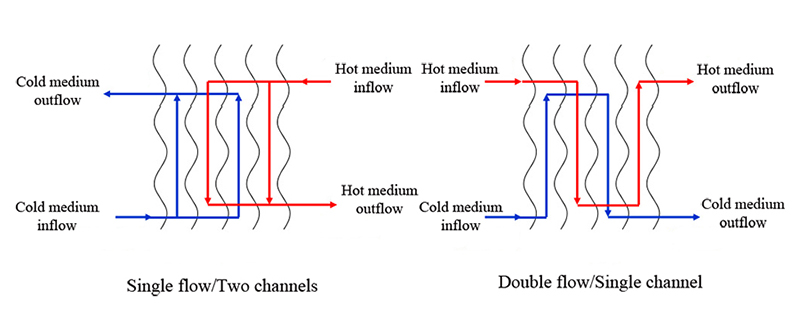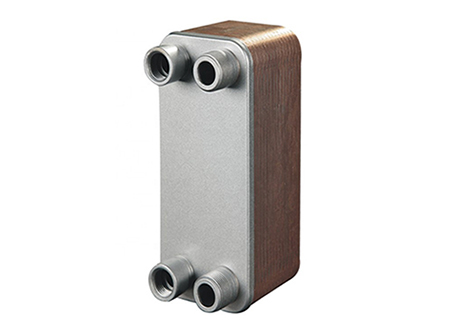Brazed Plate Heat Exchanger Installation and Maintenance
Brazed plate heat exchanger is a new type of high-efficiency heat exchanger made of a series of metal plates with a certain corrugated shape and then be brazing processed. Thin rectangular channels are formed between the plates, and heat is exchanged through the plates. Compared with the traditional shell and tube heat exchanger, brazed plate heat exchanger has a much higher heat transfer coefficient at the same flow resistance and pump power consumption. This article will introduce the installation and maintenance methods of brazed plate heat exchangers.
Brazed Plate Heat Exchanger Installation Precautions
- Arrangement of brazed plate heat exchanger flow channel
Brazed plate heat exchangers can be installed upright. Since each fluid enters and exits on the same side of heat exchanger, flow channels are generally arranged countercurrent. When using the brazed plate heat exchanger as an evaporator or condenser, separate the refrigerant outlet from the water outlet so that it can enter and exit from different flow channel.

- Installation of brazed plate heat exchanger
Before installing brazed plate heat exchanger, heat insulation with heat insulation materials to eliminate condensation water. When installing brazed plate heat exchanger, do not use connecting pipe to support and fix it. The heat exchanger must be placed on a stand and tightened with metal splint or tie rod.
- Brazed connection of brazed plate heat exchanger
Brazed plate heat exchanger must pay attention to keep its welding surface clean, free of dirt and grease when brazing connection. Before heating, the air in pipes and brazed plate heat exchanger must be replaced by using dry nitrogen. Then use a wet cloth to wrap around the root of heat exchanger short tube to protect the heat exchanger. When brazing connections, a welding rod with a silver content of 45% or more must be used. The flame must be weak flame, so that the solder can be evenly fused into stainless steel. At the same time, connecting joint of the brazed plate heat exchanger only needs to be heated to the minimum temperature required for brazing, so that it can be quickly cooled after brazing. Note that the entire brazing and cooling process must be performed under the protection of nitrogen. When cooling, do not immerse the component in water for cooling. Use a damp cloth to wipe the component to accelerate cooling.
Brazed Plate Heat Exchanger Maintenance
- Prevent icing on brazed plate heat exchangers
When temperature is lower than 0℃, the water in any heat exchanger is possible to freeze. To prevent the brazed plate heat exchanger from being damaged by low temperature, a drain valve must be installed in the air-conditioning unit. When using brazed plate heat exchanger, pay attention to keep the water circulating and heating, and drain the water when not in use. If necessary, ethylene glycol can be added to the water to prevent freezing. Pay attention to the state inside the evaporator to prevent freezing on evaporator water side. Inlet water temperature is too low, water flow is too small or water is cut off, refrigerant flushing capacity is not enough, etc., all will cause evaporation temperature to be too low.

- Avoid water hammer
Water hammer is a condition that occurs when an incompressible fluid flows through a pipe and suddenly changes its flow rate. Generally, water hammer occurs when the solenoid valve is suddenly closed. Water hammer may rupture pipes, damage valves and brazed plate heat exchangers. Therefore, delaying the opening or closing of the valve can avoid this phenomenon and protect all equipment in the liquid line.
- Water quality treatment
Due to the difference in water quality in different places and the place where the plate heat exchanger is applied, it is important to pay attention to solution of water quality problems during usual maintenance. Therefore, pay attention to the following matters.
1. Filtration of insoluble matter. In order to reduce the blockage of the insoluble matter to device, it is recommended to install a 60 mesh/sq.in filter. Pay attention to regular maintenance and cleaning.
2. Avoid corrosion and scaling. Formation of scale is caused by the concentration, temperature, pH value and other factors that cause the crystallization and precipitation of mineral salts, and adhere to the surface of brazed plate heat exchanger. The higher the temperature, concentration, and pH value, the greater the possibility of scale formation.
Stainless steel has high corrosion resistance to most chemicals, but is more sensitive to chloride ions, so its concentration must be limited to less than 300 PPM. Copper used in brazing process is more sensitive to acids and ammonia, so all pH values must be maintained between 6-8. In addition, the pH should be controlled with changes in temperature and saturation to reduce corrosion and scaling. Ammonia medium is not suitable for brazed plate heat exchanger.
- Pipe cleaning
For the plate heat exchanger cleaning methods, different applications use different methods. For the brazed plate heat exchanger commonly used in refrigeration and air conditioners, if the dirt is formed due to poor water quality, chemical cleaning, backwashing or a combination of the two can be used. If the dirt is mainly sediment, regular on-site backwashing is the easiest and most effective method. If scaling occurs, it must be chemically treated. A weak acid cleaner can be used. At about twice the normal flow rate, clean the brazed plate heat exchanger by passing the pump in opposite direction through the heat exchanger. The weak acid used as a cleaning agent can be a 5% phosphoric acid or oxalic acid solution, circulating in the system in the opposite direction to normal use. After cleaning the system, rinse the brazed plate heat exchanger with water for at least 30 minutes.

